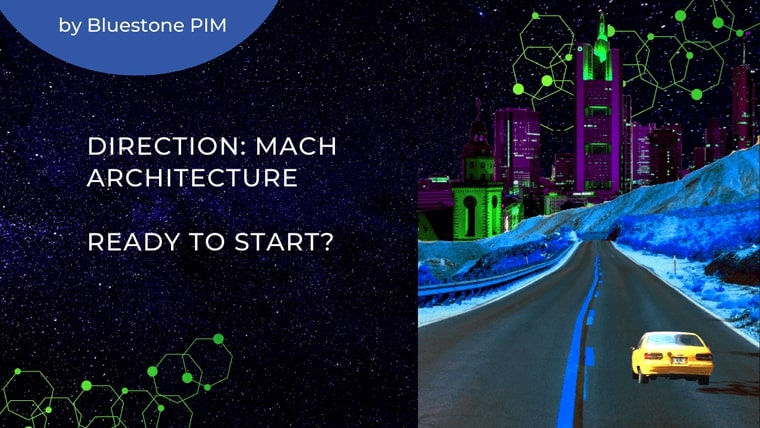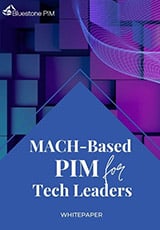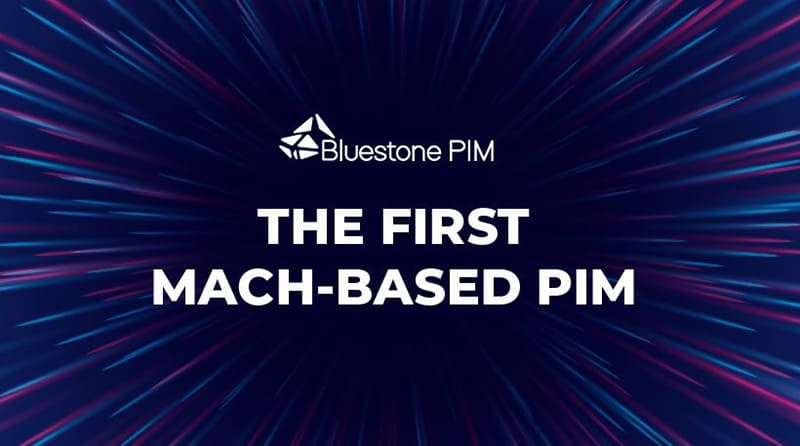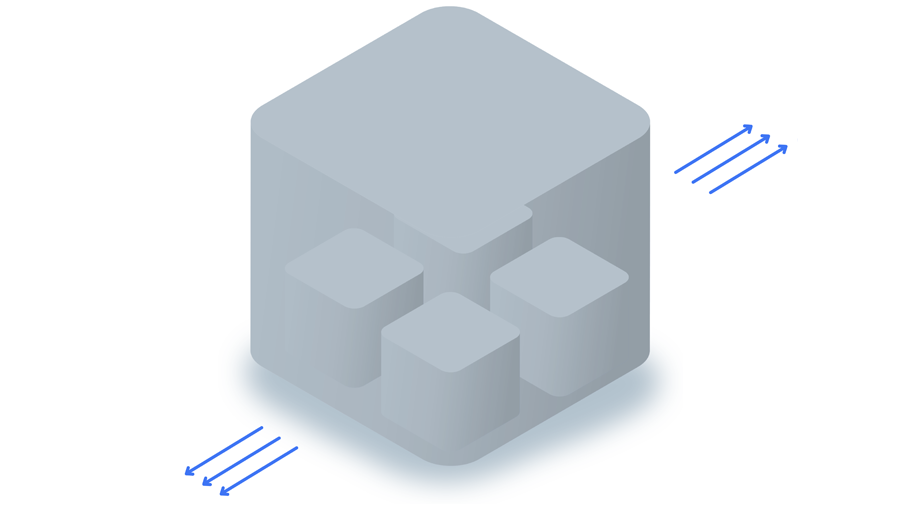Get Started with MACH Architecture: Definition, Benefits, and Strategy

Table of Contents
Customers are becoming more demanding than ever before in today's rapidly changing business environment. They expect nothing short of a frictionless, tailor-made encounter across all touchpoints, be it on the web, at a brick-and-mortar store, or on their handheld devices.
In an Infosys study of 1000 consumers in the United States, 86% of respondents said that personalization had some influence on their purchasing decisions, while 44% felt that a high level of consistency across channels would make them loyal to a brand.
Despite their desire to meet customer demands, many businesses find themselves hamstrung by legacy systems built on monolithic architecture, which offer little to no flexibility and are often too sluggish to adapt to changing software requirements.
To address this challenge, a modern and flexible approach called the MACH architecture emerged as a solution.
What Is MACH Architecture?
MACH is an acronym that stands for Microservices-based, API-first, Cloud-native, and Headless.
It is a set of four modern technology principles that form the foundation of an open and best-of-breed technology system and emphasize modular design, interoperability, and flexibility.
Let's dive into the definition of each of these MACH principles:
M for Microservices
Microservices are small, independent applications that are made to perform a specific business function (data search, product information management function), and they can be developed, deployed, and scaled independently of each other.
A microservices-based architecture breaks down a software application into these smaller components, which communicate with each other through APIs.
A for API-First
APIs (Application Programming Interfaces) allow different software components and applications to communicate with each other. In an API-first approach, the software is designed with synchronous communication in mind and APIs as the foundation, making it easier to add and integrate with other applications in the future.
Communication with other programs used to be an afterthought in software development, but with the MACH approach, it is the cornerstone.
C for Cloud-Native
Cloud-native refers to a software architecture that is designed to run on cloud infrastructure. This means that the application is built with cloud providers' components and services, making it easily scalable, resilient, and deployable on the cloud.
Cloud-native software enables businesses to take advantage of the latest cloud technologies and features as they become available, which helps future-proof their technology stack.
H for Headless
Headless is an approach that separates—also known as decoupling—the frontend user interface (the "head") from the backend functionality. By adopting a decoupled architecture, businesses can develop and maintain their backend and frontend independently, enabling them to enjoy greater flexibility and modularity.
A headless architecture can support multiple frontends, as each frontend can consume the same backend API, thus promoting flexibility and scalability across different channels, platforms, and devices.
Differences Between MACH and Monolithic Architecture
Software applications can be built using either a traditional monolithic architecture or a MACH architecture.
The former relies on a single, large application with tightly coupled components that run on a single server or set of servers and has been the predominant approach for many years.
However, as business needs have evolved, the limitations of monolithic architecture have become more apparent, despite its advantages in the past.
There are several other notable differences between MACH and traditional monolithic architecture, such as:
Modular vs Monolithic
MACH architecture is composed of independent microservices that can be developed, deployed, and scaled independently, whereas monolithic architecture is a single unit that cannot be easily separated into smaller parts.
This modular approach allows MACH architecture to be more flexible, scalable, and maintainable than traditional monolithic architecture.
Cloud-Native vs On-Premise
Another significant difference between MACH and traditional monolithic architecture is their deployment models. MACH architecture is cloud-native, which means it is designed to run on cloud infrastructure like Amazon Web Services (AWS) or Microsoft Azure. In contrast, traditional monolithic architecture is often deployed on-premise, which can be more expensive and less flexible than cloud-based deployments.
According to Zippia's Cloud Statistics Report 2023, 94% of companies were using a cloud service in 2022, a huge jump from the 61% in 2020, highlighting the growing importance of cloud-native architectures like MACH.
Api-First vs Service-First
MACH architecture is API-first, which means it prioritizes the development of APIs that enable integration and interoperability with other systems. In contrast, traditional monolithic architecture is often service-first, which means it prioritizes the development of services within the application itself.
This difference can make it easier for MACH-based systems to integrate with other systems and can increase the flexibility and agility of the overall system.
Decoupled vs Coupled
In a traditional monolithic architecture where the frontend and backend are coupled together, any changes made to one component can potentially affect the other, leading to slower development and deployment processes. In contrast, by separating the frontend and backend into independent components, it allows for more flexibility and quicker development cycles.
Decoupled architectures also enable better scalability and performance as each component can be scaled independently, whereas in a coupled architecture, scaling one component may require scaling the entire application.
By implementing the MACH architecture, companies can ensure that their tech stack is future-proof and ready to adapt to new technologies and customer demands.
Importance of MACH Architecture in Modern Commerce
The MACH architecture is designed to enable businesses to deliver a seamless and personalized digital customer experience across all touchpoints.
As revealed by Salesforce in its “State of the Connected Customer 2020” report, 76% of customers desire seamless, personalized interactions throughout their journey, ranging from product recommendations to proactive customer service.
However, companies often struggle to kickstart their omnichannel customer experience strategy due to issues such as data silos and incompatible legacy systems. As a result, they look for a digital solution that can help them achieve their business goals better and faster.
The solution can be the MACH architecture.
By leveraging modular and API-driven technologies, companies can handpick the best-of-breed solutions for each aspect of their digital experience. This approach liberates them from the constraints of monolithic systems, allowing flexibility to upgrade or replace components seamlessly.
At this point in time, you will not find any other architecture that is as flexible and scalable. So why not use the most modern solutions?
Morten Næss, EVP Technology at Bluestone
By adopting the MACH approach, you can create a flexible and agile technology stack and choose the best tools for the job, so your business can adapt to the evolving needs of your customers, build the foundation of a composable commerce ecosystem that is focused on experimentation and agility, and ensure your digital strategy evolves efficiently with the ever-changing business landscape.
7 Benefits of MACH Architecture
With a MACH approach, you can build and scale digital experiences with the best tools in the market and meet your growing business needs and your customers' expectations.
But that is not all it has to offer.
Here are some other benefits of a MACH architecture and its technologies:
Flexibility to Quickly Adapt and Iterate
The power of headless and APIs in practice means that the ease of implementing new solutions allows you to respond quickly to changing market conditions and design a better customer experience while staying ahead in the dynamic and ever-digital commerce landscape.
Having control over the entire software architecture allows for a more customized and efficient technology stack, with the added benefit of being able to add new channels and launch new products faster than ever before.
Your teams can explore new technologies and features, test them in real-time, make changes promptly based on feedback, and stay up-to-date with the latest industry trends and innovations.
Responsive and Automated Scaling
Cloud-native SaaS systems can automatically adjust to respond to sudden or unexpected market conditions, such as increased traffic or demand, without requiring any manual intervention.
This means even if your business experiences a sudden surge in online traffic due to a seasonal sale like Black Friday, your system will automatically scale up the infrastructure to handle the increased load, so your website will stay live and responsive under the heavy traffic.
Responsive and Automated Scaling
One of the greatest benefits of the MACH architecture is its capability to integrate with third-party applications.
With the unlimited possibilities of connectivity through APIs, you gain the freedom to choose from a variety of software applications and services that are specifically designed for your business needs and shape the technological environment of your software as you wish.
For instance, a retail business may use Shopify as their eCommerce platform, HubSpot to handle marketing automation, and Bluestone PIM for product information management, all integrated seamlessly with a MACH architecture.
Unified Customer Engagement at All Touchpoints
With headless architecture, development teams can decouple the front-end presentation layer from the back-end and implement it across any channels or devices.
This means companies can provide their customers with a consistent and seamless brand experience across all touchpoints while also tailoring the content and functionality to the specific needs of each channel.
This kind of personalized experience can be a key differentiator in a crowded marketplace, and MACH architecture makes it possible by providing a unified platform for managing customer data and interactions across all channels.
Faster Development and Deployment
When you need to update your platform or test a new solution, microservices mean you do not have to redesign the entire system but just implement one solution at a time.
By decoupling the front-end presentation layer from the back-end business logic, development teams can work independently and concurrently on each layer. This allows for faster iteration and deployment of updates to the front-end user interface without disrupting the back-end functionality.
Additionally, automation tools and cloud-based infrastructure can be leveraged to further accelerate development and deployment. For example, continuous integration and deployment (CI/CD) pipelines can automate the testing, building, and deployment of code changes, reducing the risk of human error and streamlining the development process.
Improved Cost Efficiency
With a modular, API-driven approach, the costs associated with maintaining and upgrading legacy systems will be reduced. Because the MACH architecture is specifically designed to be flexible and adaptable, changes and updates can be easily and quickly implemented, with fewer disruptions and delays to your business.
Expenses can also be further reduced as you do not require costly on-site hardware and software, nor do you have the need to perform maintenance and upgrades.
Additionally, cloud-based services often offer the option to scale up or down as needed without incurring any additional infrastructure costs. Most also offer flexible pricing models, allowing companies to pay only for the resources they use, further improving cost efficiency.
Future-Proof Tech Stack
A MACH architecture enables companies to future-proof their technology stack by providing an ecosystem of best-of-breed technologies that can be integrated and replaced as needed.
Companies will be able to keep up with the latest technology and market trends without having to completely revamp their current tech stack.
In contrast, monolithic architectures are often built with proprietary technologies that may become outdated or unsupported over time, leaving companies with a costly and time-consuming migration process to update their tech stack.
3 Downsides of MACH Architecture
The MACH architecture is not without its own challenges. If you implement it without being prepared beforehand or lack the commitment to maintain the architecture, your business might end up in a worse spot than before.
Like any solid business plan, it is important that you know what difficulties you can expect to encounter and how you can overcome them, and then decide if the MACH architecture is worth the extra effort.
Absence of a Ready-Made Front-End
Unlike a monolithic architecture, MACH architecture separates the front-end from the back-end, so companies can choose the best technology for each layer.
However, this means that there is no out-of-the-box front-end solution available for MACH-based systems. As a result, companies will have to invest time and resources in building their custom front-end from scratch that is tailored to their specific needs and preferences.
This often translates to higher development costs and longer development cycles.
Complex Architecture
Compared to the traditional monolithic architecture that most, if not all, developers are already familiar with, the MACH architecture may come across as a sophisticated puzzle.
The microservices approach of a MACH architecture means there will be multiple sets of APIs and interfaces within the system, along with complex integration processes as the APIs need to communicate with each other in a seamless manner.
If your team is used to working with a monolithic architecture, then learning how the MACH architecture works will be an initial hurdle to cross as they will need to have an understanding of the various new tools, frameworks, and programming languages.
Higher Operating Expenses
Because the MACH architecture is composed of various microservices and APIs that are interconnected, you will need to invest in a team of developers with the specialized knowledge and skills to add new functionalities and also manage and maintain them.
However, there are two reasons why investing in a MACH architecture will pay off in the long run:
-
Stay competitive and customer-focused. Companies will be able to adapt and respond to changing market conditions, customer demands, and emerging technologies in an ever-changing digital landscape.
-
Scale operations efficiently and effectively. With a modular approach, companies can scale their systems in a more granular manner without having to scale their entire system at once and easily add new functionalities and services to their systems as required.
While the absence of a ready-made front-end, the complex architecture, and higher operating expenses may deter some organizations from adopting MACH, they can be overcome through proper planning, expertise, and investment.
In the end, the long-term advantages of using the MACH architecture will make up for the initial challenges. However, it's important for each organization to carefully consider the advantages and disadvantages and decide whether MACH architecture aligns with their business goals and requirements.
Key Tips to Get Started with MACH Architecture
For your business to be successful with a MACH architecture, you need to do it correctly from the very beginning.
MACH is not for everyone. It will not make you successful or help you deliver to your customers if you do not know how to use it in your strategy. If you are in the process of starting a business from scratch and have something global in mind, you should definitely consider the principles of MACH.
Morten Næss
EVP Technology at Bluestone PIM in an interview for MACH Alliance
However, getting started can seem overwhelming. With so many factors to consider, it can be difficult to know how or where to begin, particularly for the evaluation and implementation processes.
To help you plan and prepare for success, here's what you can do:
Evaluation Process
When evaluating whether a MACH architecture is right for your business, consider the following factors:
-
Business goals and objectives: What are your business's goals, objectives, and pain points, and how can a MACH architecture help you achieve them?
-
IT infrastructure: Is your current IT infrastructure compatible with a MACH architecture? If not, what changes would need to be made?
-
Scalability: What are your business's scalability needs, and how can a MACH architecture accommodate future growth?
-
Technical expertise: Does my current team have the necessary skills and resources to implement and maintain a MACH architecture? Do I have to hire new developers or invest in training for my team?
-
Level of Customization: What is the level of customization and flexibility required for my business needs, and how can MACH provide that?
-
Case Studies: Are there other businesses similar to mine that have successfully implemented a MACH architecture? What were the benefits and challenges they faced?
-
Budget: What are the costs associated with implementing a MACH architecture, including any additional hardware or software requirements?
-
Cost-benefit: After knowing how much resources you will need to implement a MACH architecture, do its benefits outweigh the costs for your business?
Implementation Process
Once you have determined that a MACH architecture is right for your business, it's important to follow a structured implementation process:
-
Identify stakeholders: All key stakeholders should be on the same page. They need to be aware of the implementation process and what they are responsible for.
-
Create a roadmap: Develop a roadmap that outlines the implementation process and identifies any potential roadblocks or challenges that may arise.
-
Choose the right partners: Work with partners and vendors who have experience implementing MACH-based services and can provide you with the necessary support.
-
Train employees: Let your team familiarize themselves with the architecture, and provide them with the necessary training and resources to implement and maintain it.
-
Plan for testing: Plan and execute thorough testing to ensure that the MACH architecture is functioning as expected before full deployment.
-
Monitor and evaluate: Monitor your architecture regularly to identify areas for improvement and optimization and ensure that it continues to meet your business needs over time.
Bluestone PIM and the MACH Architecture
The MACH Alliance is made up of forward-thinking tech companies from around the world that advocate for open, best-of-breed, and future-proof tech ecosystems.
Through its MACH certification program, the Alliance welcomes individuals and companies that espouse its principles and share the best practices to jointly shape the landscape of modern technology.
Since May 2021, Bluestone PIM has been a proud member of the MACH Alliance. We have embraced the MACH architecture, and it has been the foundation of our development even before this best-of-breed approach was clearly defined.
Back in 2016, when monolithic architecture was still the mainstream approach, we knew a change was imminent. To prepare for that, we made it our goal to build a future-proof solution for our customers that would remain modern and innovative for years to come.
Knowing that the future of software development lies in the cloud, we opted to create a cloud-native system. Additionally, we chose an API-first, microservices approach as it is the most effective way to develop software in the cloud.
The combination of these two decisions led to the development of a headless architecture that offers a multitude of benefits.
The result is the creation of Bluestone PIM, the first MACH-based product information management solution, designed to empower retail and eCommerce companies and enable them to create a seamless omnichannel customer experience.
Related: How Bluestone PIM Fits in the MACH Architecture
Conclusion
The MACH architecture is a game-changer for modern commerce with its ability to provide the necessary flexibility, scalability, and future-proofing compared to traditional monolithic architecture.
As commerce continues to evolve, the MACH architecture will undoubtedly become more prevalent, and businesses that adopt it will be better equipped to meet the demands of the market.
By implementing the four MACH principles, businesses can ensure that they are building a system that is not only relevant for today but also prepared for the future.

DOWNLOAD FREE E-BOOK
The First MACH-Based PIM
Learn how modern PIM software can help you expand the market reach and design a future-proof commerce stack.
Product information management is a cornerstone of any retail or eCommerce business. Without it, they would struggle to maintain accurate and up-to-date information about their products, resulting in poor customer experiences and lost sales opportunities.
As a MACH-based PIM solution, Bluestone PIM can help your business outperform your competitors and thrive in the modern commerce landscape.
Get in touch with our advisors to learn more about our MACH-based PIM solution or schedule a demo meeting to see our platform in action.
Editor’s note: This post was originally published in February 2022 and has been updated with the latest information.



